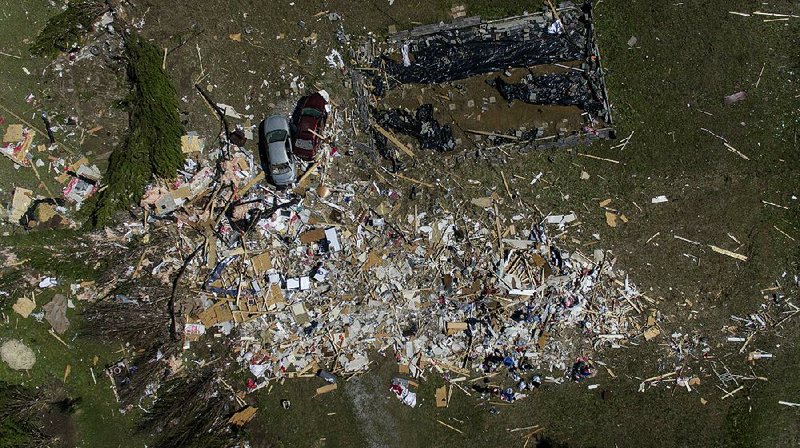BEAUREGARD, Ala. -- The youngest victim was 6, the oldest 89. Relatives said one extended family lost 10 members.
The 23 people killed in the nation's deadliest tornado in nearly six years came into focus Tuesday with the release of their names by the coroner.
They included 6-year-old Armando Hernandez Jr., known as "AJ," torn from his father's arms two days after singing in his first-grade class musical; 10-year-old Taylor Thornton, who loved horses and was visiting a friend's home when the twister struck; and Jimmy Lee Jones, 89, who perished along with his wife of six decades, Mary Louise, and one of their sons.
"Just keep those families in your prayers," Lee County Coroner Bill Harris said, two days after the disaster.
The search for victims, pets and belongings in and around the devastated rural community of Beauregard continued as heavy machinery beeped and chain saws whined. But Sheriff Jay Jones said the list of the missing had shrunk from dozens to just seven or eight.
Four children were killed, ages 6, 8, 9 and 10.
The youngest, AJ, had taken shelter in a closet with his father and older brother when the tornado hit, said Jack Crisp, the boy's uncle. The punishing winds tore the family's home apart, Crisp said, and pulled both boys from their father's arms.
"He had them squeezed tight, and he said when it came through, it just took them," Crisp said. "It just demolished the house and took them."
The boy's father and brother survived.
Jackie Jones said she and her siblings rushed to her parents' house after the storm passed and nobody answered the phone. "They usually answer on the first ring," she said.
The siblings found the home reduced to its foundation. One of their two brothers who lived at the house survived and was taken to a hospital. But Jimmy Lee and Mary Louise Jones had died along with their 53-year-old son Emmanuel.
The tornado was an EF4 with winds estimated at 170 mph and carved a path of destruction up to nine-tenths of a mile wide in Alabama, scraping up the earth in a phenomenon known as "ground rowing," the National Weather Service said. It traveled 70 miles or so through Alabama and Georgia, where it caused more damage.
Ninety people were injured in the Beauregard area, authorities said. Most have been released from the hospital.
President Donald Trump said he will visit Alabama on Friday to see the damage. "It's been a tragic situation, but a lot of good work is being done," he said at the White House.
While are some are hailing forecasting ahead of the storm a meteorological success story, others claim it exposed shortcomings in warning systems.
But the infrastructure of the affected area, lacking sturdy structures that could withstand such a force and serve as shelters, has emerged as a primary culprit for the tragedy.
By all objective standards, the National Weather Service's forecast was close to a slam dunk. Meteorologists began to sound the alarm about a severe weather threat as early as Thursday, zeroing in on the area around Lee County more than 24 hours in advance.
More than an hour before the EF4 tornado dropped, the Storm Prediction Center warned "tornadogenesis will likely occur within the next 30-60 minutes with the possibility of a strong tornado occurring."
Though timely warnings were issued, a number of factors stood in the way of the public getting them. Sirens and TV fail when the electricity is severed as fierce weather approaches. But whether people receive the alert is only half the battle.
"We need to put ourselves in the shoes of the people we're serving," wrote Kim Klockow-McClain, a social scientist at the Cooperative Institute for Mesoscale Meteorological Studies, in an email. "We need to understand their circumstances, and the forces that shape their ability to respond. Do they have options for keeping themselves safe?"
In most cases on Sunday, the answer was no.
Walker Ashley, an atmospheric scientist at Northern Illinois University, attributes much of that to building type. "A paramount issue is the large number of mobile, manufactured, and other weak-framed housing throughout that region," he said in an email. "When even weak tornado affects this type housing, the results can be disastrous -- as we witnessed Sunday."
Flimsy housing makes storm targets vulnerable. On top of that, population growth in the Deep South is adding targets and making direct hits more likely. Ashley co-wrote a study in 2016 projecting a dramatic uptick in observed tornado strikes in this region by the end of the century.
"We must find a way to empower folks living in these housing types, so that they can have the information and resources to take action when a quick fuse warning occurs," wrote Walker. "We can't just tell these people to take shelter and hope things are going to go well."
Information for this article was contributed by Kim Chandler, Jay Reeves, Jeff Martin and Russ Bynum of The Associated Press; and by Matthew Cappucci of The Washington Post.
A Section on 03/06/2019
